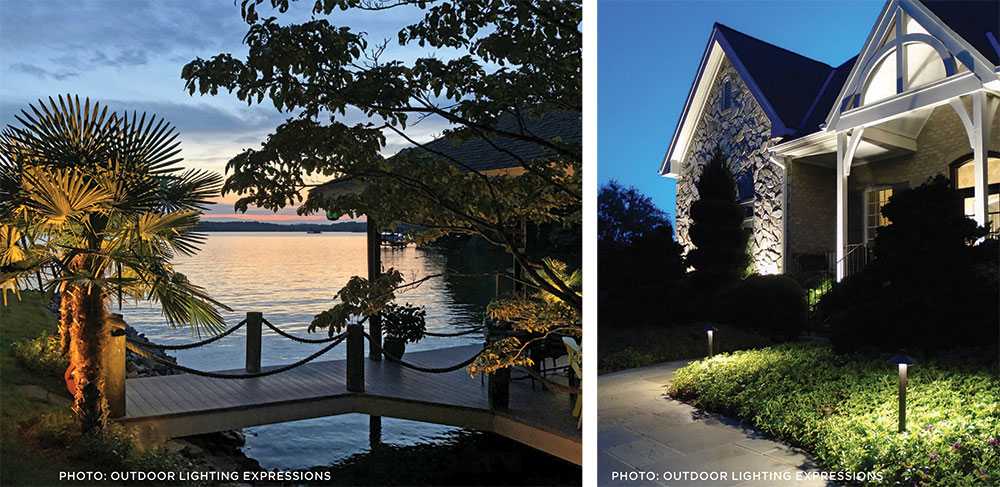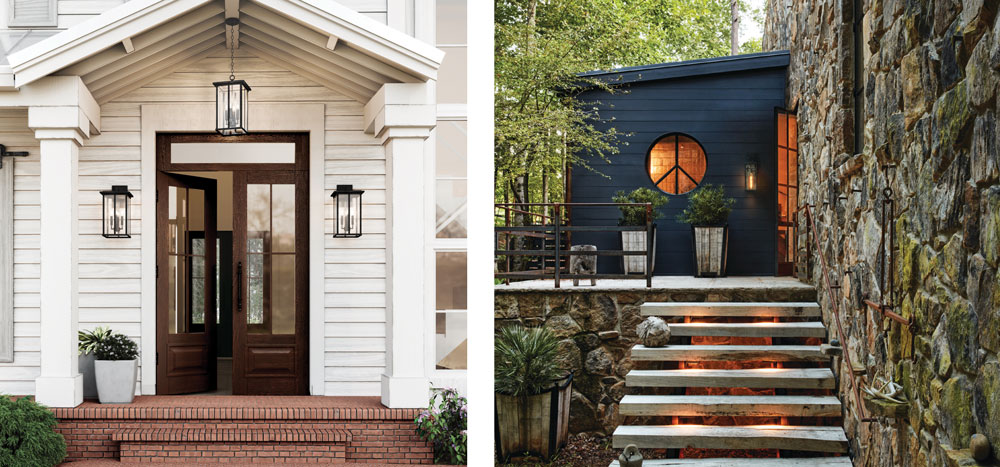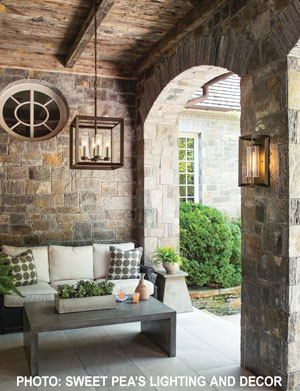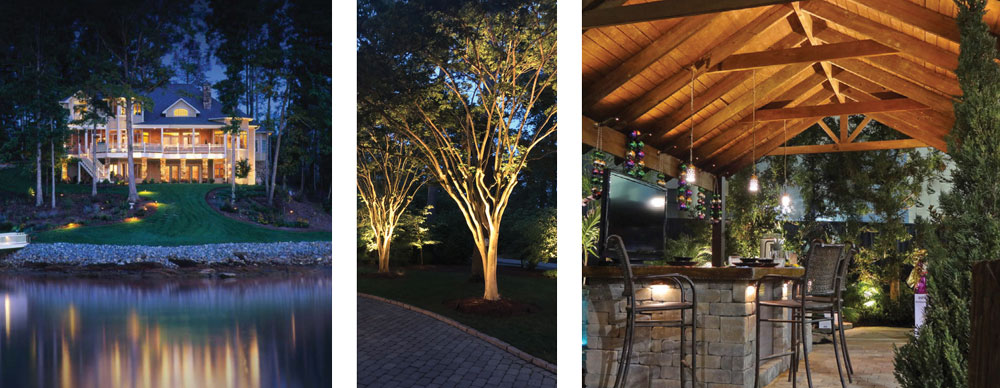 Arriving home after dark, there’s something welcoming about flipping a switch. From cold and dark to a cheerful glow, your home’s light pulls you into its warm embrace. With outdoor lighting, that same feeling comes every time you pull in the drive. Songs pay tribute to the gleam of a porch light. But outdoor lighting ventures past the porch. Even lights installed just for safety’s sake wash a home with that same warm welcome. Lakeside, outdoor lighting ventures even further—enhancing the beauty of your property and magnifying the glory of the water.
Arriving home after dark, there’s something welcoming about flipping a switch. From cold and dark to a cheerful glow, your home’s light pulls you into its warm embrace. With outdoor lighting, that same feeling comes every time you pull in the drive. Songs pay tribute to the gleam of a porch light. But outdoor lighting ventures past the porch. Even lights installed just for safety’s sake wash a home with that same warm welcome. Lakeside, outdoor lighting ventures even further—enhancing the beauty of your property and magnifying the glory of the water.
Whether you simply want to stay safe, enhance your home’s features, or spend time outdoors enjoying lakeside living, there are some things to know.
Confused by lumens, watts, and LEDs? All the choices and terminology that come with choosing both fixtures and bulbs is enough to make your head spin. Before calling a lighting professional, or even heading out to buy replacements, brush up on your lighting terminology. It will help you to understand what it’s all about.
KELVIN (K) Refers to a light’s temperature. The lower the number, the warmer the light. For most outdoor lighting, you want a warm glow. For spotlights, a higher number will give you a higher concentration of light.
LUMEN (LM) The measurement of the amount of light visible to the human eye. The higher the lumens, the brighter the light.
WATT (W) The amount of power a light uses. You want the most lumens for the least amount of watts, as found in LEDs.
LIGHT-EMITTING DIODE (LED) A type of bulb that uses about one-sixth the amount of energy as an incandescent bulb and one-half that of a halogen light.
LOW-VOLTAGE LIGHTING This phrase simply means that your lights have a low risk of electric shock and an extremely low risk of producing an electrical arc. Also, low-voltage means low power, which saves you money in energy costs.
SPREAD Refers to the number of degrees in area that your light covers
 Photos: Sweet Pea’s Lighting And Decor
Photos: Sweet Pea’s Lighting And Decor
Staying safe
The first thing most homeowners think of when discussing outdoor lighting is security. “I always recommend a floodlight on each side of the home for security,” says Kate Farmer, owner of Sweet Pea’s Lighting and Decor in Gretna. “A motion sensor over the garage is nice, but you need the ability to turn on the lights in an emergency.”
Clay Johnston, owner and senior designer of Outdoor Lighting Expressions, suggests that security floodlights be properly aimed and on timers. “Nothing is worse than having a neighbor’s security light shining in your eyes all night long,” he says. However, he also argues that landscape lighting makes your property secure without bothering your neighbors with bright floodlights.
Before shopping for floodlights, though, examine your entryway lighting. “Entries typically have fixtures too small to provide quality lighting,” says Farmer. She recommends installing larger sconces, whether on one side of the door or both, so the top of the fixture is lower than the doorframe.
Illuminating your home’s unique features
After making sure everything is secure, you’ll want to beautify the property by enhancing your home’s unique features. Outdoor lighting specialists use several techniques to achieve different effects. Highlighting, shadowing and silhouetting, uplighting and downlighting, and ground or path lighting are the most popular.
Farmer prefers to begin a lighting project by highlighting the home’s exterior corners. If you want more, she and Johnston both recommend highlighting columns, posts, trees, statues or shrubbery.
 “You can virtually light up anything to create a focal point,” says Johnston. Varying the distance, position, and color of light results in different effects, too. For instance, washing your Japanese maple with a soft light creates a magical, shadowy effect on the surface behind. Yet, pointing the light at the wall behind the tree creates a defined silhouette of it, rather than an ethereal-looking shadow. And by using a low-wattage, wide-angle floodlight, you can wash a wall or fence in light, creating a soft, ambient glow.
“You can virtually light up anything to create a focal point,” says Johnston. Varying the distance, position, and color of light results in different effects, too. For instance, washing your Japanese maple with a soft light creates a magical, shadowy effect on the surface behind. Yet, pointing the light at the wall behind the tree creates a defined silhouette of it, rather than an ethereal-looking shadow. And by using a low-wattage, wide-angle floodlight, you can wash a wall or fence in light, creating a soft, ambient glow.
You achieve uplighting and downlighting by placing fixtures either below or above the item you want to highlight. Uplighting creates a stately appearance by washing, shadowing or silhouetting an object. Downlighting, especially when placed in the eaves of your home, creates bright direct light in a given area.
Once she’s highlighted the corners, Farmer looks for dark spots. She explains that you want to eliminate existing dark areas and avoid creating new ones. “All lighting enhances the beauty of the lake but you also don’t want a fall risk. You want to see the elevation while walking up an incline, steps, or different levels of terrain.”
For this reason, ground lighting along walkways, deck stairs or piers provides a place for safe footing and draws attention to lowlying shrubs or architectural elements. Properly installed, ground lighting adds a romantic feel to your outdoors.
 Photos: Outdoor Lighting Expressions
Photos: Outdoor Lighting Expressions
Enjoying lakeside living
What is life on the lake without outdoor entertaining? Before you plan the menu and invite your closest friends, think about how lighting will play a role in your soiree.
“The first question to ask,” says Farmer, “is if the lights will be temporary or permanent.” Permanent fixtures perfect for entertaining include exterior chandeliers. These durable fixtures are designed for outdoor use and hang from under the deck, an arbor, or a porch ceiling. An exterior chandelier adds elegance to your outdoor dining space when sized and installed well.
For a standard-size chandelier, multiply the width of your table by .66. The result is the size chandelier to buy. Hang it 30 to 34 inches from the top of your table for headroom and optimal lighting.
“For a party atmosphere,” says Farmer, “bistro lights are popular.” These Edison-style bulbs give a yellowish, old-fashioned look to your patio, dock or pool area. But they’re not permanent and must be stored for the winter.
 Photos: Sweet Pea’s Lighting And Decor
Photos: Sweet Pea’s Lighting And Decor
Do-it-yourself outdoor lighting
Both Farmer and Johnston agree that outdoor lighting is best done by professionals. “Find someone with experience to bring ideas to the table,” says Johnston. “An experienced lighting designer will know how to achieve the desired effect and which fixtures to use.” He asks the homeowner a lot of questions to fish out what they like and hope to achieve. He also has a large library of project photos to help them communicate what they have in mind.
“Find a professional,” says Farmer, “because it’s an expensive project to DIY if you don’t know what you’re doing.” She begins each consultation with two questions: “What is your goal?” And “What is your budget?”
Though the low-voltage wiring for outdoor lighting is relatively affordable, the fixtures are expensive. “That’s because they’re made to withstand the elements,” says Farmer. Both experts agree that most homeowners don’t realize the expense until they start. So, Farmer recommends they prioritize their list and start with what’s most important. “Do what’s in your budget first, then build from there,” she says.
Johnston stresses that outdoor lighting professionals “are more in the effects business than the fixture business.” He says that once you decide what effect you want, an experienced designer can provide that because they know the right combination of fixture, light, color and position to achieve it—something a DIY-er would struggle to do.
What about solar?
Environmentally conscious homeowners who want to reduce their carbon footprint may think that solar fixtures are the best way to stay aligned with their values. But according to the experts, that’s not necessarily the case.
“Solar lights tend to fail and aren’t quality made,” says Johnston. “The lighting from wired lighting is far superior and we couldn’t do what we do, achieve the effects we want, with solar.”
If a homeowner burned 20 8-watt LED lights per night, they would use about 18 kilowatts of electricity per month with an approximate cost under five dollars. The energy required to manufacture cheap solar lights that you must replace frequently is much greater. Plus, they don’t stay on all night, aren’t as bright, and aren’t made to hold up in the weather.
If you want your outdoor lighting to welcome you and your guests in a warm embrace, Farmer stresses the importance of choosing the right fixture for the desired effect. “Size and proportion are the number one thing we see wrong in DIY jobs,” she says. “It’s like putting on an ugly necklace.” You can beautify. Or, you can make something already lovely, ugly. ✦
